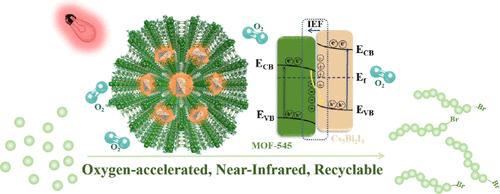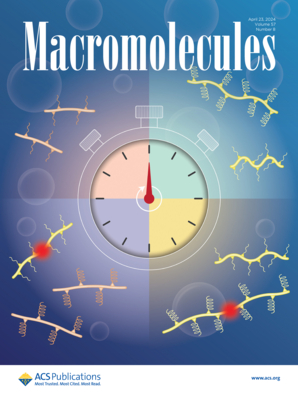Efficient Oxygen-Accelerated Near-Infrared Photoinduced Atom Transfer Radical Polymerization Mediated with S-Scheme Heterojunction Photocatalyst Composed of Lead-Free Halide Perovskite Encapsulated into Metal–Organic Framework
IF 5.1
1区 化学
Q1 POLYMER SCIENCE
引用次数: 0
Abstract
All-inorganic lead-free halide perovskite Cs3Bi2I9 was encapsulated in a zirconium-porphyrin metal–organic framework (MOF-545) to create a S-scheme heterojunction photocatalyst Cs3Bi2I9@MOF-545 for efficient copper-mediated photoinduced atom transfer radical polymerization (photo-ATRP). The close interfacial contact and the disparity in the work function between MOF-545 and Cs3Bi2I9 has been demonstrated to facilitate photoinduced charge transfer at the interface and boost the efficiency of photogenerated charge separation and utilization. The distinctive advantage of S-scheme charge transfer enabled the optimized Cs3Bi2I9@MOF-545 to effectively regulate the Cu-mediated photo-ATRP of diverse monomers under 850 nm near-infrared (NIR) light with good terminal fidelity, even achieving high monomer conversion on the barriers of 5 mm PP board and 4 mm pigskin. In a large reaction volume (250 mL), the monomer conversion reached approximately 99% with a first-order kinetic behavior under 850 nm NIR light, demonstrating potential for industrial applications. High photocatalytic activity was maintained after 10 cycles of use in organic solvent (DMSO) or 6 days of water immersion. Furthermore, it is unveiled that the limited oxygen can enhance trithanolamine (TEOA) oxidation to accelerate Cu-mediated photo-ATRP in heterojunction photocatalysts for the first time. This study offers insights into designing MOF-based photocatalysts to augment Cu-mediated photo-ATRP performance under NIR-light.

由封装在金属有机框架中的无铅卤化物包晶组成的 S 型异质结光催化剂介导的高效氧气加速近红外光诱导原子转移辐射聚合作用
在锆卟啉金属有机框架(MOF-545)中封装了全无机无铅卤化物包晶 Cs3Bi2I9,从而创建了一种 S 型异质结光催化剂 Cs3Bi2I9@MOF-545,用于铜介导的高效光诱导原子转移自由基聚合(photo-ATRP)。实验证明,MOF-545 和 Cs3Bi2I9 之间的紧密界面接触和功函数差异促进了界面上的光诱导电荷转移,提高了光生电荷分离和利用的效率。S 型电荷转移的独特优势使优化的 Cs3Bi2I9@MOF-545 能够在 850 纳米近红外(NIR)光下有效地调节铜介导的不同单体的光-ATRP,并具有良好的终端保真度,甚至在 5 毫米 PP 板和 4 毫米猪皮的屏障上实现了高单体转化率。在大反应体积(250 mL)下,单体转化率达到约 99%,且在 850 纳米近红外光下具有一阶动力学行为,显示了工业应用的潜力。在有机溶剂(DMSO)中使用 10 个周期或在水中浸泡 6 天后,仍能保持较高的光催化活性。此外,研究还首次揭示了有限的氧气可以增强三硫醇胺(TEOA)的氧化作用,从而加速异质结光催化剂中铜介导的光-ATRP。这项研究为设计基于 MOF 的光催化剂以提高近红外光下铜介导的光-ATRP 性能提供了启示。
本文章由计算机程序翻译,如有差异,请以英文原文为准。
求助全文
约1分钟内获得全文
求助全文
来源期刊

Macromolecules
工程技术-高分子科学
CiteScore
9.30
自引率
16.40%
发文量
942
审稿时长
2 months
期刊介绍:
Macromolecules publishes original, fundamental, and impactful research on all aspects of polymer science. Topics of interest include synthesis (e.g., controlled polymerizations, polymerization catalysis, post polymerization modification, new monomer structures and polymer architectures, and polymerization mechanisms/kinetics analysis); phase behavior, thermodynamics, dynamic, and ordering/disordering phenomena (e.g., self-assembly, gelation, crystallization, solution/melt/solid-state characteristics); structure and properties (e.g., mechanical and rheological properties, surface/interfacial characteristics, electronic and transport properties); new state of the art characterization (e.g., spectroscopy, scattering, microscopy, rheology), simulation (e.g., Monte Carlo, molecular dynamics, multi-scale/coarse-grained modeling), and theoretical methods. Renewable/sustainable polymers, polymer networks, responsive polymers, electro-, magneto- and opto-active macromolecules, inorganic polymers, charge-transporting polymers (ion-containing, semiconducting, and conducting), nanostructured polymers, and polymer composites are also of interest. Typical papers published in Macromolecules showcase important and innovative concepts, experimental methods/observations, and theoretical/computational approaches that demonstrate a fundamental advance in the understanding of polymers.
 求助内容:
求助内容: 应助结果提醒方式:
应助结果提醒方式:


